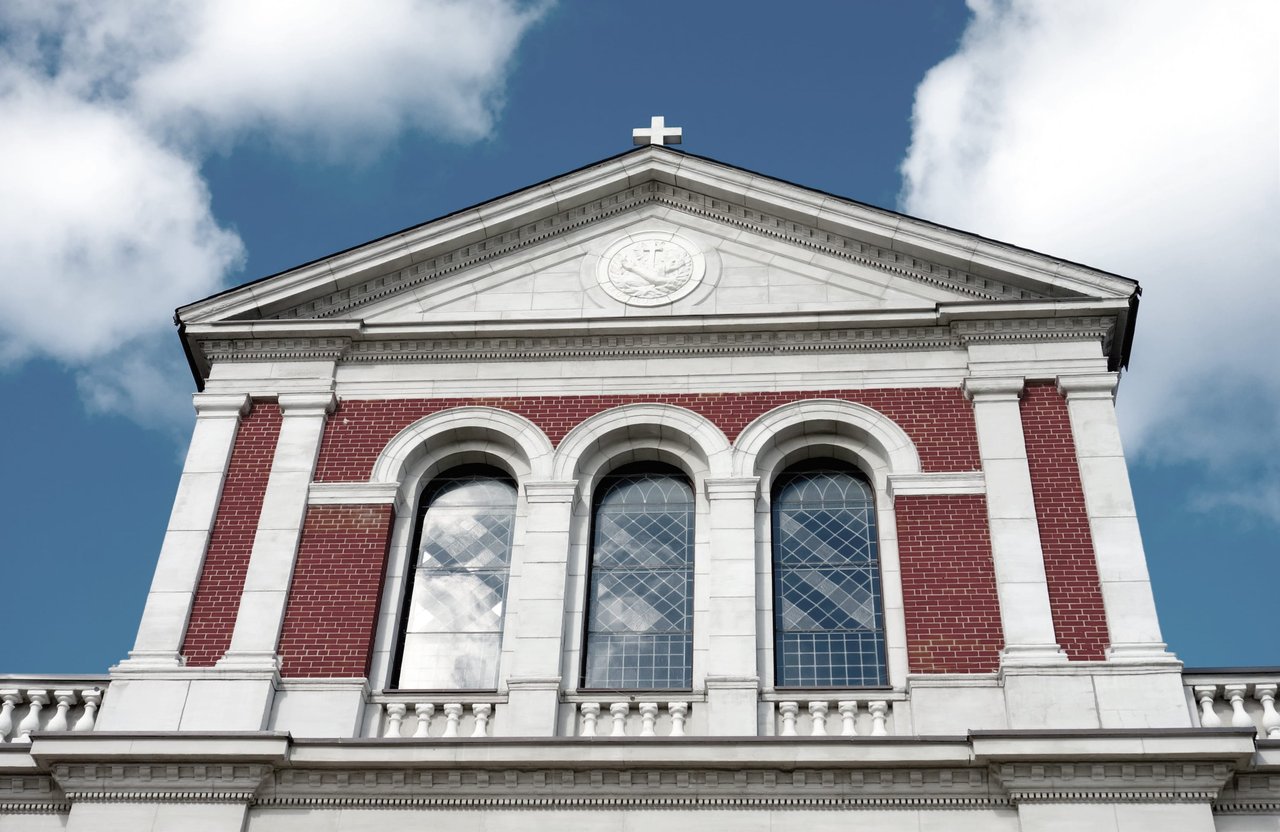It was always peculiar to me how much chewing gum was trampled into these sidewalks, fossils permanently embedded in this pavement. Even as a child I remember playfully jumping over these little landmines; and with each safe step on the bright concrete, a small victory.
I feel the bite of the bitter cold, as I stare up at the grandeur of St. Clare’s Roman Catholic Church – some snow now covers its archways and the stone sills of its stained glass. Its symmetrical poise, in roman fashion, is a testament to the history of the community that built it. It is surprisingly timeless, despite having recently celebrated its hundredth anniversary.
I can smell freshly made pizza from The Big Slice, whose patio area faces the church. In times like these, it’s difficult to enjoy its friendly, welcoming atmosphere; yet its home-style comfort food can still be devoured. For decades, its neon sign of a chef serving a whole pizza was a landmark of this neighbourhood. It’s branding must have recently had a facelift.
I have always had a personal affinity to this community. As a child, nearly every summer day in her care, my grandmother would walk with me and my sister down St. Clair Avenue West. This street, from Westmount Avenue to Lansdowne Avenue, has been christened ‘Corso Italia,’ as it was once home to a large number of Italian immigrants – it is Toronto’s second Little Italy.
Our daily ritual, albeit a distant childhood memory, was steadfast. Each morning, my grandmother would take us to play with other children on the grounds of St. Clare Catholic School, followed by a prayer and candle-lighting at the church. Then, tightly gripped to the rail of my sister’s stroller, I would walk alongside my grandmother as we hurried through the many stores and boutiques in completion of the day’s errands. Our stops oftentimes included Grace Textiles or one of the many independent Italian grocers. My grandmother was a socialite – she knew and would chat with everyone up and down the bustling street.
Our walks always took us to pay a visit to my great-aunt who lived nearby on Earlscourt Road, followed by a break at Tre Mari Bakery for especially delicious, sugar-covered donuts. Once we reached Prospect Cemetery at Lansdowne Avenue, we would turn around and walk all the way back to Northcliffe Avenue, where my grandparents lived for nearly thirty years.
When we arrived home, my grandfather would already be cooking – veal involtini, stewed nearly all day in a hearty tomato sauce. The first words out of his mouth as we walked through the door were the imperative: “butta la pasta,” an equivalent to “let’s get cooking.” While my grandmother worked away in the kitchen, my sister and I would play with mother’s younger brother, all to the tune of an Eros Ramazzotti song which played, live, on a vintage television in the living room – a family relic from the sixties. By the end of dinner, the tablecloth was stained with drops of homemade red wine and the remnants of cookies and nuts that accompanied an espresso nightcap; the dining room was always loud with emotion, laughter and countless stories. Needless to say, my childhood experience was rich with culture and quintessentially Italian-Canadian.
Although a rare sight, you can still run into some of the old, Italian residents at one of the last remaining espresso bars, chatting in a language now foreign to these streets. They are monuments of culture, despite being incredibly withered by their old age.
So much of this neighbourhood has changed in the last few decades.
St. Clair Avenue West was settled in the mid-1800s, and was primarily an agricultural community immediately north of the metropolitan core. It was only after a wave of immigration from Italy that surged in the early sixties, coupled with the movement of Italians from Toronto’s Little Italy on College Street, that this area began to develop its cultural identity. By 1980, there were over thirty-five thousand Italians living in this enclave. Italian grocers, bakeries, clothing stores, restaurants and ice cream parlours began to emerge.
For many Italian-Canadians, Corso Italia is renowned for the celebrations that occur here during the World Cup. I am told by my family that on July 11, 1982, when the referee blew the final whistle that awarded Italy a 3-1 victory over West Germany and the country’s third World Cup title, the residents of this neighbourhood spontaneously and ecstatically poured into the street. People climbed busses and rooftops in revelry. Over three hundred thousand people participated, shutting down the street for nearly twenty blocks.
I even had the pleasure of participating in World Cup festivities. When Italy won the World Cup in 2006, my entire, extended family attended Corso Italia to celebrate. The street was packed with fans sporting the Azzurro blue jersey, while proudly waving the three-coloured flag for as far as the eye could see. This spectacle was unlike anything I ever experienced before. However, my parents still attest that 1982 was “way better.”
My grandmother argues that the 1982 victory gave Italian-Canadians a sense of pride; but this was not always the case. Upon immigrating to Canada, Italians felt a tremendous pressure to assimilate. If groups of Italians were caught congregating on the street, it was often by police baton that they were separated. The consensus was that Italians were here to make up the working class, with companies employing them primarily for their physical labour. As a result, many Italians initially found themselves in manufacturing and construction. Likewise, Italians came here with the intention of working hard and making enough money to return to Italy once conditions improved. As was the case for my grandparents and many others that initially possessed this outlook, they never did return. Instead, they sowed their seeds, bought houses, raised families and influenced Canadian culture.
As I continue my walk, I stand under the original sign of Consiglio’s, a kitchenware company that has long since left this neighbourhood. The original sign still stands, dull yet still majestic in its retro, seventies fashion. It's large, round light bulbs are remarkably tawdry. It’s metal rusts, yet some colour still comes through. I could not imagine every sign along this street looking like this, reminiscent of a carnival; the street lively, bustling with energy and camaraderie.
Even by the time I got to experience the cultural beauty of this neighbourhood, most of the Italians had already moved north. They were residing in communities such as Vaughan and Richmond Hill. My mother and grandmother insist that the affinity and warmth the former residents of this neighbourhood shared were unparalleled. I am thankful that I caught its dying glimpse, and can attest that it is still woven into the fabric of these streets.
What is most important to me about this neighbourhood is what it represents – a community of immigrants that left a place tarnished by war with nothing but a dream – a dream of a better and brighter future. To this day, this is something incredibly inspiring to me: the notion that you do not have to accept things the way they are. And if you have the courage to change your destiny, then anything is possible.
Today, “Corso Italia” is no longer an Italian ethnic enclave, but home to a variety of ethnicities. However, its demographic is still largely comprised of newcomers. Since my grandparents moved to Maple in the late nineties, coming down here is a rarity. As I sit here nostalgic of my childhood and the unified culture that once filled these streets, it pleases me to think that this place will be the backdrop to new hopes and aspirations.
By Alessandro Valente

